|
In
these enlightened times, almost every company boasts wired supply
chains, online processes, and intelligent networks. The Wired 20
is a sampling of such companies and organisations (we have included
government departments and educational institutions) with one key
difference: these are entities that have deployed it to significant
material benefit or are doing so to innovatively address existing
problems. That explains the diversity of the listing. There's a
film distribution company that hopes to beam the latest blockbusters
to theatres in remote areas, a government department that may well
be the country's most successful e-commerce business, and a pharma
company that is experimenting with a PDA-enabled field force. There
are also the usual suspects whose usage of it is more traditional.
Still, as the instance of a paint maker whose acquisitions may have
been partially funded by it investments shows, 'traditional' has
some scope.
 |
| Adlabs' Shetty: He has an instant solution
to piracy |
Magic Lantern Redux
ADLABS Digital distributor
Can it combat motion pic piracy?
Manmohan Shetty, the Chairman and Managing Director of Adlabs Films,
thinks so. In April, the company promoted a joint venture with Mukta
Arts, Mukta Adlabs Digital Exhibition. This company hopes to connect
400 smaller towns across India through satellite to facilitate the
digital distribution of Bollywood blockbusters. The idea is to release
motion pics in small towns on the same day they are released in
the metros. The adventitious (some would say, main) benefit: a reduction
in distribution costs by 90 per cent. "We plan to introduce
satellite uplinking to theatres in remote towns across India,"
explains Shetty. "We'll beam them the latest blockbusters."
Then, there's Adlabs' offline strategy: converting motion pics into
digital format. The advantage: traditional prints cost around Rs
60,000, one reason why most motion pics are released only across
300 theatres in large cities; digital ones cost Rs 2,700 and can
be displayed in theatres willing to incur an one-time infrastructure
cost of Rs 15 lakh. Today, some 75 theatres across small towns in
Maharashtra, Gujarat, Chattisgarh, Madhya Pradesh, West Bengal,
and Uttar Pradesh have signed on for the digital experience. May
their tribe increase.
-Dipayan Baishya
 |
| Asian Paints' Choksi: IT helped us do
it |
Money From IT
ASIAN PAINTS
The united colours of connectivity
Most people are
aware that Asian Paints is one of the 10 largest decorative paints
companies in the world. As many are sure to know that acquisition
has formed the basis of the company's global gambit. Here's the
nub: it may have made everything possible. Not convinced? "We
needed to unlock capital from existing businesses to fund growth,"
says Manish Choksi, VP (it & Strategic Planning). "The
focus was on leveraging technology to increase efficiency."
Choksi claims that a large part of the Rs 366.4-crore operating
cash flow Asian Paints has generated over the past three years can
be attributed to its Rs 90-crore investment in it. Today, the Rs
2,042-crore company handles 1.2 million online invoices and 3,000
GB of data every year, boasts over 100 VSATs, and has deployed 120
Cisco routers. Its ERP solution helps it close monthly accounts
in four days flat, down from the 20 it used to take earlier. And
the supply chain management one has enabled it to turn over its
inventory nine times a year (as against four earlier). "We
would now like to extend our connectivity outside the organisation
so that all stakeholders can benefit from the extended enterprise,"
says Ashwin Dani, Vice Chairman, Asian Paints. Way to go.
-Dipayan Baishya
Connecting BITS
BIRLA INSTITUTE OF TECHNOLOGY & SCIENCE
Networked campus
 |
| Users@BITS: Reason to smile |
On January 7, 2004,
the largest backbone network in an educational institute in India
went live. The constituents: 20 km of cable, 4,000 access points,
a high-redundancy three-tier network architecture, long-range ethernet,
wireless 802.11b access in some areas, bleeding-edge network security
and advanced routing technologies. No, this isn't at any of the
IITs, it is at the Birla Institute of Technology & Science.
BITS is, arguably, one of the five best engineering schools in India,
but until a year ago it was struggling with outdated it infrastructure.
Then the institute and the bits Alumni Association embarked on a
project to set up a gigabit network backbone. "The hallmark
of an intelligent society is the ability to organise something substantial,"
says Vivek Paul, Vice Chairman, Wipro, and an alumnus of bits who
was involved in the project. Size isn't the same as quality and
Professor L.K. Maheshwari, Director, bits, Pilani Campus, hopes
"the network will improve our quality of education". If
the one-year project spearheaded by Wipro and Cisco with design
expertise from alumni and student interns is any indication, it
already has.
-Alokesh Bhattacharyya
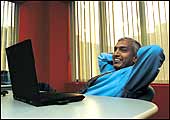 |
| Rangu Salgame, President, India & SAARC:
Top dog |
Internet Surfer
CISCO INDIA
Infrastructure-block maker/user
It companies love
to talk about eating their own dog food. The now defunct eCompany
magazine once had Oracle's Larry Ellison on the cover with the requisite
line about dog food for an article on how the company saved over
$1 billion by using its own technology. So, it's no surprise to
this writer when Shailesh Naik, the Managing Director of Cisco Asia-Pacific
Internet Business Solutions Group, resorts to the canine metaphor
to explain his company's use of technology. That's evident in Cisco's
Delhi HQ, which boasts a 802.11 WI-FI network; most employees tote
laptops connected to the internal network. All Cisco-Cisco calls
from anywhere to India and vice versa is through Cisco IP phones
over the company's network. And the laptops of most employees are
configured with softphones that serve as mirrors of the individual's
office extension-the company is waiting for India's antiquated regulations
concerning voice calls over the internet to change to start using
this. Somehow dog food seems an inadequate description; this is
the equivalent of a seven-course meal for canines.
-Kushan Mitra
Wired? Not Quite
EAST INDIA HOTELS
Wireless hospitality
 |
| EIH Chairman Biki Oberoi: Wireless is
the way to go |
Providing wireless
internet access to guests isn't all there is to the wired status
of the Oberoi hotels, although the chain was the first in India
to do so. "Offering high-speed internet access is becoming
a must for any top drawer hotel," explains Indrani Ghosh, Vice
President (Information Technology), East India Hotels, "and
when we decided to upgrade our systems a few years ago, we saw that
wireless was the emerging trend and would be the most sensible way
to go." Most processes at the chain that spends between 2 per
cent and 3 per cent of its turnover (Rs 383.3 crore in 2002-03)
on it are online, its centralised reservation system (a first, again,
for an Indian chain and this was implemented way back in 1999) doubles
up as a customer relationship management (CRM) one, and the individual
hotels, independent booking agents, and the chain's contact centre
all feed into and off the reservation system. "This helps us
maximise our yields by offering differing room rates and schemes
much like the way airlines do." Indeed, EIH's contact centre
experience has been successful enough for the company to partner
with India's National Association of Software and Service Companies
and offer its expertise in establishing and managing call centres
to companies wishing to set up call centres in India. Bravo!
-Kushan Mitra
 |
| ERNET's Rai: Wired education |
Connecting Academia
Educational and Research Network (ERNET)
Internet Protocol pioneer
It isn't history
that fetches ERNET, an autonomous society that operates under the
aegis of the Ministry of Information Technology, a place on this
list: The Wired 20 is immune to the fact that ERNET was the country's
first real Internet Service Provider (ISP). Nor is it scale, although
the entity founded in 1986, to connect India's premier educational
and research institutions has come a long way since: today, it serves
close to 500 educational institutions and boasts 13 nodes across
the country, and a dedicated C-band satellite centre in Bangalore.
What does is its initiative to become the ultimate educational aid
by convincing universities and colleges in India and in other parts
of the world to share resources over what will be the mother of
all networks. And what does is the fact that ERNET is building India's
first Internet Protocol Version 6.0 (IP v.6) network. "We have
to do this because the number of IP addresses we can offer through
old protocols is limited," explains Gulshan Rai, Executive
Director, ERNET. "There are thousands of new subscribers (read:
students) who join our member institutions every year; we have to
provide each an e-mail address and a webpage." And a window
to the world.
-Kushan Mitra
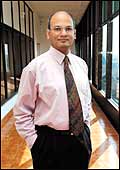 |
| HDFC Bank's Ram: IT is an integral part
of banking |
Banking On IT
HDFC BANK
Smart user
C.N. Ram, the 46-year
old head of information technology at HDFC Bank, was the company's
fourth employee. That stands to reason. "Technology will remain
an integral part of our business, not just a support function,"
says Aditya Puri, Managing Director, HDFC Bank. Over its lifetime,
the bank has spent Rs 600 crore on it. The results show: HDFC Bank
adds 3,000 customers a day and 74 out of every 100 transactions
it handles do not involve a branch. IT@HDFC Bank isn't just about
retail. The bank's ENet facility allows companies and their suppliers
to link their respective enterprise resource planning and supply
chain management solutions to HDFC Bank. As far back as 1997, the
bank launched a similar offering for stock exchanges and now handles
over 65 per cent of daily settlement transactions across India's
bourses. And it is involved in the Reserve Bank of India's Real
Time Gross Settlement process. "IT isn't an option any more,"
says Ram. "If we don't have it, we cannot work." Hear,
hear!
-Dipayan Baishya
 |
| HLL's Mohan: Wired supply chain wielder |
The Ultimate Supply Chain
HINDUSTAN LEVER LIMITED
Reachus Maximus
It seems only
apt that the company with the widest distribution reach in India,
HLL-IT services, directly and indirectly, some 4 million outlets-have
the smartest supply chain. RSNet (Redistribution Stockists Net),
is one part of it. This connects 3,500 stockists in 1,200 towns
who account for 80 per cent of the company's sales. The benefit:
HLL can take orders on a continuous replenishment system. The other
part is Suppliers Net, which links the company to all major suppliers,
again facilitating smart ordering on a continuous replenishment
system. "These have given us a capability to respond to customer
needs through daily replenishment (that's the buzzword here) ,"
says K.G. Mohan, General Manager (IT), HLL.
-Dipayan Baishya
IT Is It
ICICI BANK
Look Ma, no branches
 |
| ICICI Bank's Vohra: An embeded IT-budget
is it |
That isn't really
true; at last count ICICI bank boasted some 450 branches. Still,
there's overwhelming numerical evidence of the bank's branch-neutral
strategy. Of the 32 products the bank offers to retail customers,
28 can be availed online; over 5 million of ICICI Bank's 6 million
retail banking customers have registered for internet banking; 50
per cent of all retail banking transactions are conducted over ATMs;
and there are 150,000 registered users for the bank's SMS service.
There's more: in partnership with Reliance Infocomm, the bank has
launched mobile banking services on a java-enabled phone. "We
don't have an it budget as such," says Pravir Vohra, Head (Retail
Technology Group), ICICI Bank. "It is embedded in the business
plan of each business." The Gods, it is evident, are smiling
on ICICI Bank: given that customers can book pooja offerings for
the presiding deities at Tirupati, Sidhi Vinayak, Vaishnodevi, and
countless other shrines, that isn't surprising.
-Priya Srinivasan
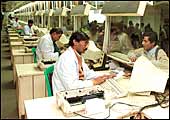 |
| Indian Railways: Steel, copper and fibre
come together |
E-biz #1
INDIAN RAILWAYS
Wired! Wired!! Wired!!!
India's most successful
e-commerce business doesn't make too much noise about the fact.
In its first year of operation, ending August 2003, it registered
revenues of around Rs 53 crore. The site, www.irctc.co.in, is run
by the Indian Railways Catering and Tourism Corporation (IRCTC),
and allows visitors to book railway tickets online. The world's
largest employer, Indian Railways-it employs close to 15 lakh people-is
also the second largest spender on it among government departments
(the Department of Telecommunications is #1). A senior Rail Ministry
officer boasts that Indian Railways and its subsidiaries are equipped
with the latest hardware and software. And many of its processes,
like the recently launched Freight Operations Information System,
are online. Attribute that to the Centre for Railway Information
Systems (CRIS), a nodal organisation that handles all of the Railways'
infotech needs. And no, an IPO isn't in the offing.
-Kushan Mitra
The Online Organisation
INFOSYS TECHNOLOGIES
The 7 per cent solution
 |
| Infosys' Gopalkrishnan: An ancillary benefits
of being wired |
It shouldn't surprise
anyone that Infosys Technologies spends between 6 per cent and 8
per cent (the average, 7 per cent, explains the sub-head) of its
annual turnover on wiring up its innards. After all, there's nothing
out of place about a company in the business to spend Rs 225 crore
on it (there it is, that dog food thing again). ''As purveyors of
technology, it is imperative that we provide the latest for our
employees,'' says Kris Gopalkrishnan, Deputy Managing Director,
Infosys. ''Our employees work at the cutting edge of technology
and have to be abreast of what is happening globally.'' Truth be
told, the bulk of Infosys' it spend goes into hardware to meet its
growing number of employees (20,000-odd at last count). And it spends
a mere 0.5 per cent of turnover on information systems (is); the
comparative figure is 2 per cent for its global peers. Gopalkrishnan
attributes this to the cost-efficiency of the Indian programmer.
''Internationally if a pc costs, say, $1,000 (Rs 46,000), the background
software support costs almost as much; in India software support
infrastructure comes at a fraction of the cost.'' Today, close to
90 per cent of Infosys' process-from leave applications to training
to purchase requisitions-are online. ''Being wired is a key competitive
edge,'' explains Gopalkrishnan. Nothing, it is evident, works as
well as saying, we've been there, done that.
-Venkatesha Babu
 |
| LG's Bose: IT is about cost consciousness |
Cost-effective Communicator
LG ELECTRONICS INDIA
IT for cost-control
LG's Infotech backbone
is probably comparable to that of other consumer durables companies
of similar size and vintage. What differentiates the company, arguably,
is the emphasis on cost. LG has 40 branches, as many stocking points,
and around 60 remote area offices (RAOs) across the country. These
are connected through a point-to-point Virtual Private Network (VPN),
with a VSAT back-up. VPN isn't exactly cheap, so the company will
soon shift to a national long-distance link with a VPN back-up for
all nodes except the RAOs. "All contact points except the RAOs
will get much higher bandwidth and a speed that is 20-30 per cent
higher than that offered by the VPN for much lower cost," says
Arindam Bose, Head (IT), LG. Earlier, to reduce internal communication
costs across the offices, LG had moved to an instant messenger that
rode on its internal network. Every bit counts.
-Ananya Roy
Wired auto
MARUTI
IT-in-manufacturing benchmark
 |
| A MUL dealership: Wired to the plant |
Somewhere in the
depths of Maruti's sprawling plant in Gurgaon (no Korean cars allowed,
please), sits a nondescript two-storey building. Inside the building
is a huge server farm. This network (Maruti's 'extranet') connects
each and every one of Maruti's 450 unique dealers, a network of
over 300 suppliers, Maruti HQ in central Delhi, Suzuki HQ in Hamamatsu,
Japan, and, international dealers in Europe and West Asia. Current
wisdom has it that real-time information holds the key to manufacturing
efficiency. Maruti's experience is testimony to that. In the past
few months, the company has increased production from 1,500 to 2,000
cars every day with the gains coming from manufacturing efficiencies
that in turn, arise from instantaneous flow of information from
suppliers to company to dealers and vice versa. That's something
-Kushan Mitra
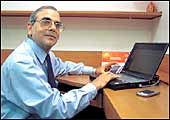 |
| Piramal's Chawla: Maintaining a record
of firsts |
Pharma Pioneer
NICHOLAS PIRAMAL
The connected pharmaceutical firm
We were the first
in the business to deploy an enterprise resource planning solution,
the first to build a business intelligence warehouse, and the first
to adopt online distribution planning." That's Harish Chawla,
the Head of it at Nicholas Piramal, proudly reeling off his company's
achievements. Well, the reason the company makes this list is another
first: Nicholas Piramal may well be the first Indian pharma company
to adopt field-force automation. No, this isn't about an army of
Aibos selling the company's products to doctors, it is about a pilot
project that involves internet-enabled-PDA-toting medical reps.
As you read this, some 100 of the company's reps are out there,
toting PDAs through which they can access information on sales,
account receivables, and inventory positions. The benefit: it reduces
cycle times that can go as high as 15 days to next to nothing. Next
step: PDAs for all 2,000 employees. Wired? You bet.
-Priya Srinivasan
E Is For Exchange
NSE
The modern stock exchange
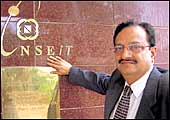 |
| NSE.IT's Naralkar: A veritable money multiplier |
The National Stock
Exchange is today the third largest stock exchange in the world
(in terms of volumes traded) after NYSE and NASDAQ. The exchange
handles just under 2 million trades a day. The secret of this success?
Technology. NSE was the first exchange in India to offer comprehensive
online trading solutions to members. First it empanelled a clutch
of it vendors to offer connectivity solutions to members and their
main clients. Then, when demand zoomed, it set up an IT arm of its
own, NSE.IT. Apart from looking after the technology requirements
of the exchange, this arm offers services to other exchanges, mutual
funds, banks, and just about anyone else. The exchange itself spends
around Rs 50 crore on it every year. It's return on investment.
"How do you calculate RoI for something that grows the business
itself?" asks Satish Naralkar, the Head of NSE.IT. Touche!
-Priya Srinivasan
 |
| Reliance's Mukesh Ambani: Reaching out
to desktops too |
Face-time Fundamentals
RELIANCE INDUSTRIES
Desktop displays
Like other large
companies of its ilk, reliance industries uses technology to reach
out to its 30,000 employees and its suppliers and vendors, accelerate
speed of decision making, and improve process efficiencies (including
an initiative to use GPS-enabled trucks to find out just where shipments
of supplies and products are at any point in time). What's impressive,
however, is the sheer scale of it all and the novelty of having
a feature-laden desktop. The scale, first: some 600 terabytes (the
equivalent of the storage capacity of 9 million CDs) of information
resides on the Reliance network, spread across almost 25,000 desktops,
2,000 routers connected to datacentres in Mumbai and Bangalore through
dedicated 2.5 GBPS lines that can be scaled up to 10 GBPS. From
his desktop, an employee can host audio- and video-conference calls,
access the company's knowledge management portal (called Gyan Mandir,
or temple of knowledge in Hindi), and benefit from a multi-cast
facility that allows the company broadcast training sessions and
messages from the chairman and senior execs direct to desktop. That's
nifty.
-Dipayan Baishya
 |
| B.S. Nagesh: Everything is IT |
In The Detail
SHOPPERS' STOP
Wired retail
Retail is a complicated
business," starts Shoppers' Stop Customer Care Associate and
Managing Director & CEO B.S. Nagesh. "You deal with one
customer out of one square foot, sell one stock keeping unit, and
create one moment of misery, delight, or magic." The man isn't
done yet. "It is important for retail companies to be fully
supported by technology because you create millions of such moments
of misery, delight, or magic." Well, Shoppers' Stop, one of
India's few profitable retail establishments (2002-03 profits: Rs
14 lakh), has done just that. Over the past five years, it has invested
Rs 22 crore in technology and this year it will burn Rs 6 crore
(and Rs 5 crore every year from next), not chump change for a Rs
300 crore retailer. The company uses it for just about anything:
merchandise management, sales analysis and warehouse replenishment.
The piece de resistance: a BconnectB suite from Siemens that connects
110 vendors (supplying 80 per cent of the company's merchandise)
and allows them to add, remove, or shift their products across the
chain's 13 stores in nine cities. Complex, maybe; efficient, definitely.
-Dipayan Baishya
 |
| SSKI's Shah: IT helped him go retail |
Dotcom Survivor
SSKI
The connected brokerage
Circa 1997, Mumbai's
S.S. Kantilal Ishwarlal Securities was just another traditional
brokerage that saw the internet as a way to reach out to retail
customers (at that time, a mere 10 per cent of its business came
from retail investors). "We saw the retail investor as the
future in a country with a 27 per cent savings rate," says
Tarun Shah, CEO. So, the company invested some Rs 20 crore in wiring
itself up, a little more on maintenance, and launched a retail brand
Sharekhan. Alas, the dotcom bubble burst and SSKI found itself scrambling
to balance its online investments with offline revenues. It decided
to press on: today, it services 30 per cent of its retail investors
online; is connected to banks and depositories to facilitate real-time
transactions; and has 150 Sharekhan Shops across 80 cities in perennial
chat mode with the central trading room. Today, 75 per cent of the
brokerage's business comes from retail investors. This cat roared.
-Priya Srinivasan
Satellite Trucking
TRANSPORT CORPORATION OF INDIA
GPS pioneer
 |
| TCI's Agarwal: Keeping track with IT |
When you handle
Rs 35,000 crore worth of traffic by road as TCI does, it helps to
know where your trucks are. So, Vineet Agarwal, tci's Executive
Director decided to try an IT tool called avl (Automatic Vehicle
Location) on 80 trucks. AVL comprises a GPS (Global Positioning
System) receiver, a GSM modem, and an antenna, all installed in
the truck. TCI's control centre at Gurgaon was provided with a GIS
(Geographical Information System) software. The GPS receiver bounces
signals off geo-stationary satellites to infer the co-ordinates
and the velocity of the truck. Along with the time, this information
is transmitted by the GSM modem as an SMS to the control centre.
Over the next 18 months, Agarwal plans to install the system on
all 650 company owned trucks. That's a start.
-Alokesh Bhattacharyya
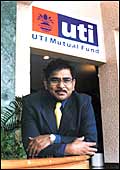 |
F.Q. Kolman, President, UTI MF: His e-investment
paid off |
Two-Letter Tool For Three-Letter
Trust
UTI
Efficient implementor
First UTI made
a hash of things (and how). Then, under a new Chairman, it turned
around smartly. As this closer look at the institution reveals,
purely in terms of efficiency-gain, UTI wins the top-prize for effective
deployment of it on the investor services front. A sampling: the
time taken to allot or encash units has come down from anything
between 15 days and 30 days to one day; average office space across
cities has, from 5,000 square feet to 2,000; the annual phone bill,
by Rs 1 crore; and unit holders can now conduct business from any
UTI Investor Services office (earlier, they could do this only from
the office where the unit had been issued). All this is courtesy
a Rs 42-crore investment in linking investor services offices across
57 locations to the institution's headquarters in Mumbai's Bandra
Kurla Complex and its registrar located on the outskirts of the
city. This information infrastructure services some 10 million investors.
Happy investors, may we add.
-Priya Srinivasan
|
